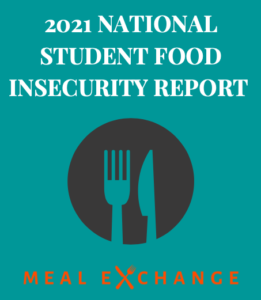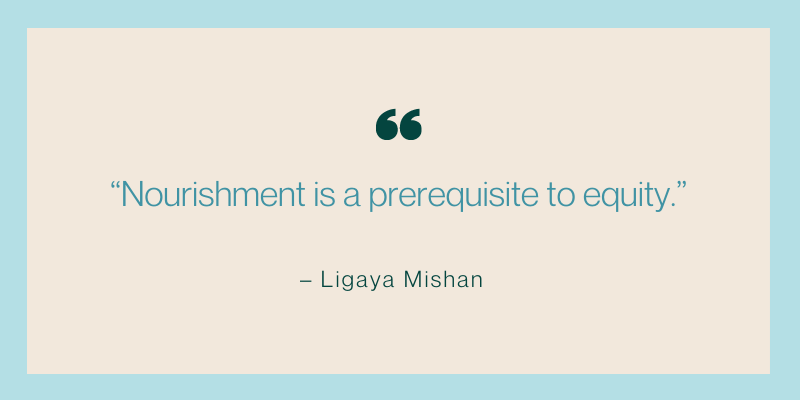An inclusive, healthy, and sustainable food culture is one that includes opportunities for skill building, knowledge production, local healthy food, and communal eating – it’s one that builds a culture of care. But the campus food culture that many students experience is influenced by frameworks that discourage healthy eating practices, such as schedules that don’t allow enough time to eat and eating spaces that don’t nurture healthy eating habits.
 It is well-established that physical and mental health is supported by healthy eating habits. But current campus food culture makes it difficult for students to prioritize eating as a nourishing pause during their busy days. Meal Exchange, in its 2021 “Promoting Food Secure Campuses” report, indicated that, “Promotion of unhealthy food options across campuses has shown to negatively affect students access to healthy food; unhealthy food options are advertised over healthier options and are often more affordable than healthier options. The Task Force on Campus Food Services Final Report found that a ‘lack of access to fresh food and an over abundance of unhealthy food options forces students to indulge in fast food options, which lack the nutrients necessary for a healthy diet.’”
It is well-established that physical and mental health is supported by healthy eating habits. But current campus food culture makes it difficult for students to prioritize eating as a nourishing pause during their busy days. Meal Exchange, in its 2021 “Promoting Food Secure Campuses” report, indicated that, “Promotion of unhealthy food options across campuses has shown to negatively affect students access to healthy food; unhealthy food options are advertised over healthier options and are often more affordable than healthier options. The Task Force on Campus Food Services Final Report found that a ‘lack of access to fresh food and an over abundance of unhealthy food options forces students to indulge in fast food options, which lack the nutrients necessary for a healthy diet.’”
The Challenges Students Face
 Before the pandemic, it was clear that many students were not feeling physically or mentally healthy: over 40% of post-secondary students reported that they sacrificed buying healthy food to pay for school and other necessities (Meal Exchange report, 2016) and almost 60% of students reported that they felt isolated or very lonely (NCHA-II report, Spring 2019). The pandemic has accelerated and exacerbated these issues for many students. Since the beginning of the COVID-19 pandemic, students have seen their costs of living increase and their incomes reduced. According to Meal Exchange’s 2021 Food Insecurity report, the number of students coping with food insecurity during the pandemic increased to almost 57%. Furthermore, they have experienced increased isolation, which has compounded what were already challenging circumstances.
Before the pandemic, it was clear that many students were not feeling physically or mentally healthy: over 40% of post-secondary students reported that they sacrificed buying healthy food to pay for school and other necessities (Meal Exchange report, 2016) and almost 60% of students reported that they felt isolated or very lonely (NCHA-II report, Spring 2019). The pandemic has accelerated and exacerbated these issues for many students. Since the beginning of the COVID-19 pandemic, students have seen their costs of living increase and their incomes reduced. According to Meal Exchange’s 2021 Food Insecurity report, the number of students coping with food insecurity during the pandemic increased to almost 57%. Furthermore, they have experienced increased isolation, which has compounded what were already challenging circumstances.
To build a better campus food culture means to consider these challenges in a student’s life. This task is not as simple as suggesting students eat better food or develop food literacy. And the food bank model can only provide short-term solutions for a small percentage of those in need.
The path to a better food culture
A better campus food system is no more complex than existing food systems. Current campus food systems are simply ecosystems, and ecosystems can adapt to changing needs.
Our current campus food culture evolved because of a need to feed large, transient populations. But it has arrived at an unhealthy place. If we are to address the pressing needs of people and the environment, the culture must change. Educational institutions can model and encourage a change in values outside the classroom through a reimagined food culture IF they accept that every moment in a school is a potential teaching and learning moment.
Getting an education should not be a game of survival. If we want to support students’ physical and mental well-being, if we want to support academic excellence, and if we want to ensure equity among students, it starts with food. More specifically, it starts with an intention to build campus food policies around a culture of care.
There are already shining examples of efforts to do this on campuses across Canada. These initiatives are being implemented on low budgets and with the support of student volunteers. They have provided a path for campus administrations to follow and support more actively. Please see Joshna Maharaj’s IG Live conversation with CLP’s Dalhousie University Student Researcher, Isabel Teramura, and Lakehead University Student Union VP Advocacy, Sanjana Sharma, to learn more about the work that is being done on their campuses.

If we accept this statement and understand that equity is at the core of healthy communities, then we must examine more closely how all students eat their way through their days at school.

